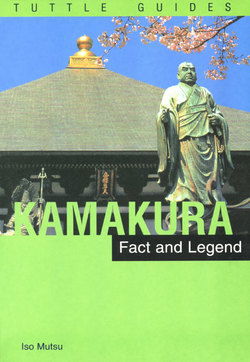Читать книгу Kamakura: Fact & Legend - Iso Mutsu - Страница 8
На сайте Литреса книга снята с продажи.
ОглавлениеForeword
by Lady Bouchier
(Dorothy Britton)
IT GIVES me great joy that this, one of my favorite books, has at long last been reissued after having been out of print for nearly forty years. A generous grant from the prestigious Tokyo Club has made possible this new and revised edition, which has been brightened with new photographs—this time in color—carefully selected by the author's son Ian, a talented producer of many prize-winning cultural films on Japan.
My own beloved copy—the Second & Enlarged 1930 edition is worn from constant use, for it has been our family's vade mecum on the historic city of Kamakura for as long as I can remember. We lived in Yokohama, where I was born, and my father built a summer villa in Hayama, only a few miles from Kamakura, which my mother and I made our home on returning to Japan soon after World War II. Whenever there was time she and I would drive to Kamakura and visit temples and historic spots, clutching our Kamakura: Fact and Legend and letting the late Countess Mutsu be our enthralling guide.
And what a wonderful guide she continues to be, in spite of the inevitable changes that time has wrought, for her beautifully written book is the product of a lively, inquiring mind and is based on a foundation of deep scholarship.
She would spend hours with the abbots and high priests of the various temples and shrines, amassing information with which to "unseal for the Western world," as the Japan Times put it, "much of the secret of Kamakura's magnificent past." The newspaper, reporting her funeral of June 10, 1930, also recorded the unheard-of participation of a Buddhist priest at the Christian service in Kamakura's Methodist church when the vice abbot of the important Zen temple Engaku-ji, resplendent in gold and scarlet brocade, ascended the pulpit to deliver a special eulogy and chant a sutra for the solace of the departed soul.
I was too young, alas, to remember her, but my mother spoke often of the delightful teas she and mutual friend Maya Lindley Poole enjoyed with the lovely Countess Iso Mutsu in Kamakura in the twenties, talking about their shared interest in music and the colorful history of the ancient city they loved to explore.
Young Hirokichi Mutsu, born in 1869, followed in the footsteps of his famous parent Munemitsu, the "father of Japanese diplomacy." While preparing for his diplomatic career and studying law at Cambridge in 1888, Hirokichi fell in love with the beautiful and talented Gertrude Ethel Passingham. It was seventeen long years, however, before they were able to marry, following which they spent four years at the Japanese Embassy in London where, as First Secretary and then Counselor, Count Mutsu, who had by then succeeded to the title, helped to organize the highly successful Japan-British Exhibition that ran for six months at London's White City.
The Count retired after their return from London to spend the rest of his life administering a foundation he had created, aimed at social improvements mainly in education and the position of women, while the Countess set about delving into the history of the twelfth-century shogunal capital, Kamakura, where they decided to live, and devoted her considerable literary ability to writing this definitive in-depth work.
They settled near the sea with its peerless view of Mount Fuji across Sagami Bay, particularly lovely in dark relief as the sun goes down, leaving the sea aflame in roseate gold. When she became a Japanese subject on her marriage, Ethel took the name Isoko, "Beach Child," suggested by her husband because she so loved the seashore. She was bathing there when the Great Kanto Earthquake of 1923 struck, and a vivid description is included in the 1930 edition of this book. Seven years later, "How beautiful! The sunset!" were the last whispered words of this lady who so loved the history and the beauty of Kamakura. Much of that beauty still remains. And what is sadly gone lives on in the pages of this remarkable book.
Hayama, August 1994
